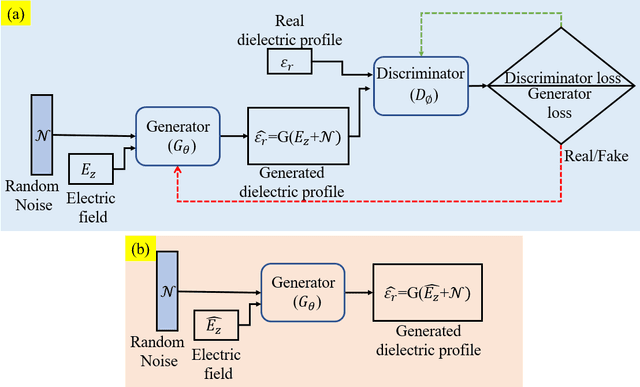Kainat Yasmeen
Estimation of Electrical Characteristics of Inhomogeneous Walls Using Generative Adversarial Networks
Sep 29, 2022



Abstract:Through-wall radars are researched and developed for the detection, localization, and tracking of human activities in indoor environments. Electromagnetic wave propagation through walls introduces refraction, attenuation, multipath, and ghost targets in the radar signatures. Estimation of wall characteristics (dielectric profile and thickness) can enable wall effects to be deconvolved from through-wall radar signatures. We propose to use generative adversarial networks (GAN) to estimate wall characteristics from narrowband scattered electric fields on the same side of the wall as the transmitter. We demonstrate that the GANs, consisting of two neural networks configured in an adversarial manner, are capable of solving the highly nonlinear regression problem with limited training data to estimate the dielectric profile and thickness of actual walls up to 95\% accuracy based on training with simulated data generated from full-wave solvers.
Circularly Polarized Fabry-Perot Cavity Sensing Antenna Design using Generative Model
Sep 29, 2022



Abstract:We consider the problem of designing a circularly polarized Fabry-P'erot cavity (FPC) antenna for S-band sensing applications. The spatial distribution of peripheral roughness of the unit cell of FPC's partially reflecting surface serves as an important design optimization criterion. However, the evaluation of each candidate design using a full-wave solver is computationally expensive. To this end, we propose a deep generative adversarial network (GAN) for realizing a surrogate model that is trained with input-output pairs of antenna designs and their corresponding patterns. Using the GAN framework, we quickly evaluate the characteristics of a large volume of candidate designs and choose the antenna design with an axial ratio of 0.4 dB, gain of 7.5 dB and, bandwidth of 269 MHz.
Sparsity Based Autoencoders for Denoising Cluttered Radar Signatures
Jan 29, 2021



Abstract:Narrowband and broadband indoor radar images significantly deteriorate in the presence of target dependent and independent static and dynamic clutter arising from walls. A stacked and sparse denoising autoencoder (StackedSDAE) is proposed for mitigating wall clutter in indoor radar images. The algorithm relies on the availability of clean images and corresponding noisy images during training and requires no additional information regarding the wall characteristics. The algorithm is evaluated on simulated Doppler-time spectrograms and high range resolution profiles generated for diverse radar frequencies and wall characteristics in around-the-corner radar (ACR) scenarios. Additional experiments are performed on range-enhanced frontal images generated from measurements gathered from a wideband RF imaging sensor. The results from the experiments show that the StackedSDAE successfully reconstructs images that closely resemble those that would be obtained in free space conditions. Further, the incorporation of sparsity and depth in the hidden layer representations within the autoencoder makes the algorithm more robust to low signal to noise ratio (SNR) and label mismatch between clean and corrupt data during training than the conventional single layer DAE. For example, the denoised ACR signatures show a structural similarity above 0.75 to clean free space images at SNR of -10dB and label mismatch error of 50%.
 Add to Chrome
Add to Chrome Add to Firefox
Add to Firefox Add to Edge
Add to Edge